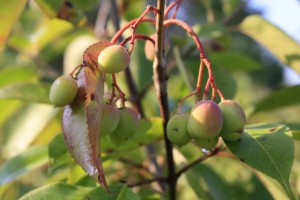Birds and Berries
For gardeners, from beginner to avid, there is great satisfaction watching a flock of native birds happily dining on juicy berries from a shrub on your property. This especially true when the berry-producer was selected for this very purpose. It’s visual confirmation that your landscaping is a benefit to local ecosystem and its species. The cherry on top is the front row seat you get to witness the buffet!
The great news is there is no big secret to attracting birds to your property. The concept is simple; provide native plants that produce berries that birds love and when ripe they will show up. Easy! You build it and they will come.
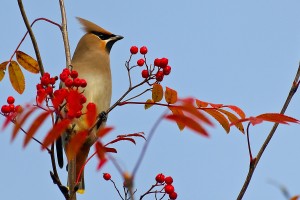
Why Can’t I Just Use Bird Feeders?
I already have bird feeders isn’t that enough? This is a fair question. Although bird feeders are a great way to support local species of birds they can only be a part of the birdscaping equation. Native trees and shrubs do a few things that typical seed-based feeding stations cannot
-
Many bird species do not or eat only small amounts of seed in their natural diet
Some bird species cannot eat seeds. Cedar waxwings, for example, will not be found at your feeder filled with sunflower seeds. However, they will descend upon your berry-producing native’s with glee. Choosing species that sport berries will attract birds that you may never get a chance to see with conventional bird feeders.
-
Providing nutrients that seeds cannot
Berries are ideal for birds, especially before migration, as they provide high levels of beneficial fats and carbs to store energy for long flights. Choosing natives that birds have been accustomed to eating for generation after generation is best. The majority of non-native berry-producers do not provide the adequate amount energy because they are very low in beneficial fats that birds desperately need to weather the cold or prepare for migration.
Spread the goodness
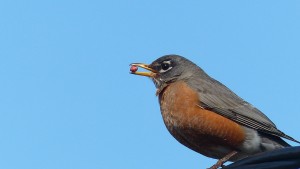 An incredible and often understated benefit to planting native-berry producers is the effect it will have on the regional ecosystem. Birds are airborne seed dispensers. Meaning when they consume berries from a beneficial native plant on your property they will then go and spread these seeds far and wide. This will promote the growth of healthy ecosystems in your community. One native shrub on your property may lead to multiple across nearby parks, greenspaces and ravines. One tree or shrub can be a gift that keeps on giving to enrich your local area.
An incredible and often understated benefit to planting native-berry producers is the effect it will have on the regional ecosystem. Birds are airborne seed dispensers. Meaning when they consume berries from a beneficial native plant on your property they will then go and spread these seeds far and wide. This will promote the growth of healthy ecosystems in your community. One native shrub on your property may lead to multiple across nearby parks, greenspaces and ravines. One tree or shrub can be a gift that keeps on giving to enrich your local area.
Early Flowers
Choosing native berry-producers also means that before the fruiting process many species sport flowers for pollinators. This gives a shrub a double purpose. The native bees will benefit as well.
Five great choices
Mountain Ash (Sorbus americana)
The mountain ash and cedar waxwing seem to go hand in hand. The bright orange berries that are displayed in large quantities invite many different species during the fall.
Bird species: waxwings, robins, jays, grouse and others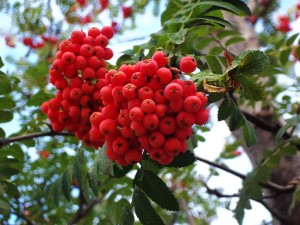
Zone: 3 to 6
Height: 15 to 30 feet
Spread: 15-30 feet
Light: Full Sun
More Information Here
Canadian Serviceberry (Amelanchier canadensis)
Serviceberries are know for the explosion of flowers they sport in early spring. But then as the flowers fade it brings forth a bounty of dark purplish berries in early summer. They are similar in shape and color to blueberries. This small tree is great option those who value a balance of aesthetics and food production.
Bird Species: waxwings, catbirds, robins, orioles, jays and others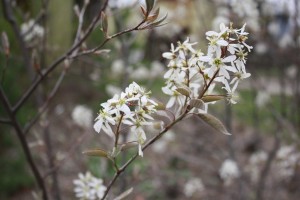
Zone: 4 to 8
Height: 25 to 30 feet
Spread: 15 to 20 feet
Light: Full to Part Sun
More Information Here
Nannyberry (Viburnum lentago)
Produces large purple berries that are great for attracting a wide range of bird species. In particular the nannyberry is palatable to the elusive brown thrasher. For properties located near large open spaces or rural regions may find this rusty brown beauty poking around for some fresh berries.
Bird species: Robins, bluebirds, thrashers, catbirds, cardinals, waxwings and others
Height: 14 to 16 feet
Spread: 6 to 12 feet
Light: Full to Part Sun
More Information Here
Winterberry (Ilex verticillata)
This shrub is tough and provides great winter interest aesthetically. The vibrant red berries are an important part of the diet of certain birds who overwinter. The berries are toxic but research shows that they lose some of the toxicity after the first frost which leads to feast for those who stay for the long cold winter.
Bird species: Robins, bluebirds, waxwings, jays and others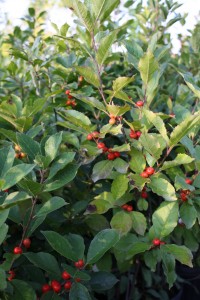
Zone: 3 to 9
Height: 3 to 12 feet
Spread: 3 to 12 feet
Light: Full to Part Sun
More Information Here
Red Osier Dogwood (Cornus sericea)
Known in landscaping for its brilliant red branches this native also produces valuable berries with high fat content. These are attractive berries for migrants who want to up their stores of energy.
Bird species: Robins, bluebirds, catbirds, vireos, kingbirds, juncos, warblers, wild turkey and others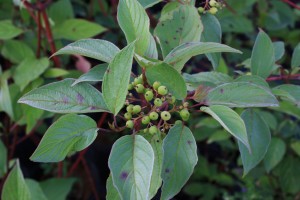
Zone: 3 to 7
Height: 6 to 9 feet
Spread: 7 to 10 feet
Light: Full to Part Sun
More Information Here
Honorable Mentions
-Staghorn Sumac (rhus typhina)
– Juniper species (juniperus spp.)
– Other Viburnums (Elderberry and Arrowwood)
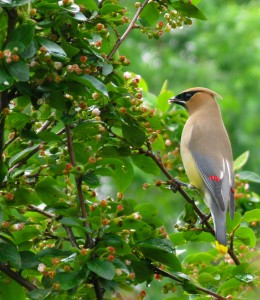 Lets get planting
Lets get planting
Spring is a great time to get started birdscaping your property. Adding a couple berry-producing natives is a great first step to feeding birds naturally. So lets get planting! Also, there are many other ways to raise the level of bird friendliness on a property. Last year we profiled the art of choosing species based upon the insects and caterpillars they host which turn into bird food. Check it out here. Certain perennials also can provide food for birds. There are numerous options!
Why not add a few (or lots) of berry-producers to your landscape this year and get your binoculars ready. You may have more winged visitors with an appetite for berries!
